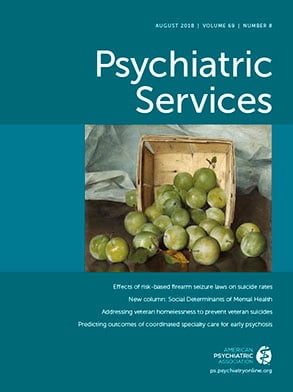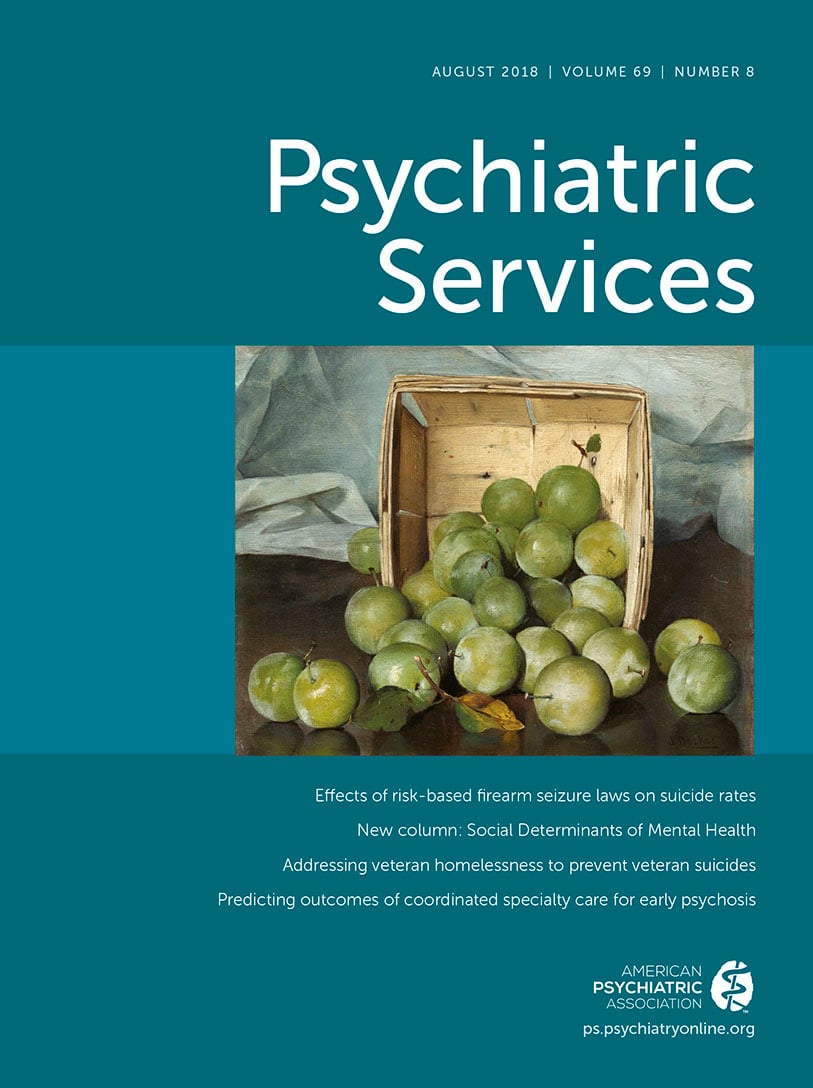Despite the profound health costs of cigarette smoking among patients with serious mental illness and evidence that cessation treatment works in this population (
1), mental health providers at community mental health centers (CMHCs) consistently report that they infrequently (<20%) provide smoking cessation treatments to patients with serious mental illness (
2). Contrary to the common perception among health providers (
3), patients with serious mental illness are frequently willing (
4) and able to quit smoking if they are given appropriate support (
1). Although evidence exists that comprehensive organizational change models have reduced smoking among patients in mental health settings, some strategies are so complex that implementation may be neither scalable nor sustainable (
5). Given the limited time and resources available in CMHCs, it is vital to identify low-burden strategies to overcome barriers and increase the delivery of evidence-based treatment for smoking (
5).
Major barriers to delivering smoking cessation treatment in CMHCs include providers’ lack of time, lack of training, and assumption of low patient interest (
2,
3). Using a consolidated framework for implementation (
6), we hypothesized that decision support tools, shown to save time in primary care, would overcome the barriers of time constraint and provider misassumption. Low-burden academic detailing would address clinicians’ perceived training deficits. Specifically, provider training with feedback has been used in primary care to increase provider implementation of evidence-based smoking cessation treatment (
7). Using the decision support tool combined with academic detailing and data-driven feedback, we can improve care by gathering patient-reported information to prompt the clinician to deliver treatment based on patient needs.
Given that these low-burden strategies hold promise in primary care settings, we present evidence to assess the effect of these strategies on treatment delivery in the CMHC setting. We evaluated two quality improvement strategies, decision support and academic detailing with data-driven feedback, in four CMHC clinics. We examined whether these strategies increased delivery of evidence-based smoking cessation treatment and whether they were temporally associated with decreased smoking prevalence among patients in CMHCs.
Low-Burden Implementation Strategies
A quality improvement initiative was conducted in four CMHC clinics in Missouri to implement evidence-based smoking cessation treatment from mid-2014 to mid-2016. The initiative was supervised by a multidisciplinary quality improvement team through monthly phone conferences. This protocol was approved by the institutional review board of Washington University/BJC Healthcare. All patients received an annual assessment that included tobacco use. All clinics offered group smoking cessation counseling.
Decision support.
Data were collected from patients by a paper-and-pencil survey completed in the waiting room in June 2014 and 2015. The survey assessed current smoking status, interest in quitting or reducing smoking, and interest in receiving cessation medication and cessation counseling. These data were immediately made available to providers to facilitate care during the patients’ appointments.
Academic detailing with data-driven feedback.
This strategy included one hour of annual training and feedback for all providers (psychiatrists and caseworkers). Using the 2008 clinical practice guideline for treating tobacco use and dependence, we developed training cards based on the 5As treatment model (Ask, Advise, Assess, Assist, and Arrange). Each card included talking points and resources tailored for patients in four smoking cessation phases (motivation, cessation, maintenance, and relapse recovery). The cards were available in all offices and on the clinic’s intranet site. Training also covered medication use (nicotine replacement therapy, varenicline, and bupropion). We provided feedback to all providers regarding patient interest in cessation treatment and treatment rates.
Study Measures
Pharmacy and medical records were used to evaluate the percentage of patients who received a prescription each month for smoking cessation pharmacotherapy and the annual smoking prevalence among all clinic patients before, during, and after the quality improvement initiative. The percentage of patients who received a prescription was based on the population of patients served by the pharmacy rather than on all clinic patients. We used data routinely collected in these clinics. Current smoking is assessed annually and defined as active use of any tobacco products in the past 90 days (data missing for <.9% of patients in 2014–2016). A homogeneity Z test was used to compare proportions of patients receiving treatment and the overall clinic smoking prevalence before and after the intervention.
Results
CMHC patients had high smoking prevalence. Among adult patients served by the clinics in 2014, 57% (N=1,940 of 3,379) were current smokers, and 43% (N=1,439) were not current smokers (includes former smokers). In 2014, 55% (N=1,858) of adult patients were female, 55% (N=1,858) were white, 41% (N=1,386) were black, 2% (N=68) were Asian, 1% (N=34) were Hispanic, and 1% (N=33) were Native American. The mean±SD age was 45.1±14.0. The distribution of diagnoses, as indicated by the patient profile at these clinics, was as follows: schizophrenia or schizoaffective disorder (N=1,115, 33%), mood disorders (N=2,129, 63%), posttraumatic stress disorder (N=372, 11%), and borderline personality disorder (N=270, 8%).
These low-burden strategies were well received. Three hundred patients were offered the decision support patient survey by the front desk staff, and 100% completed it. These patients represented 25% of all patients (N=300 of 1,200) who showed up for appointments during the two implementation months. Ninety percent of providers (N=108 of 120) received academic detailing with feedback.
Low-burden strategies increased provider treatment and decreased smoking prevalence. We found an increase in provider adoption of evidence-based treatment, as indicated by a fourfold increase between 2014 and 2016 in prescriptions issued for cessation medication (including nicotine patch, nicotine gum, nicotine lozenge, and varenicline but not bupropion because it was prescribed for multiple conditions other than smoking cessation). The proportion of patients receiving cessation medication increased from 5% in 2014 (N=69 of 1,492 smokers) to 18% in 2016 (N=264 of 1,465) (z=12.3, p≤.001), as indicated by data from the clinic pharmacies. This increase was observed at both pharmacy 1 (6% to 16%) and pharmacy 2 (3% to 24%). In addition, we found a decrease in smoking prevalence among clinic patients, from 57% (N=3,379) in 2014 to 54% (N=3,088) in 2016 (z=2.63, p≤.001). [A figure depicting an increase in prescribing of smoking cessation medications and a decrease in prevalence of smoking is available as an online supplement to this column.]
Discussion and Conclusions
We implemented two low-burden strategies, decision support and academic detailing with feedback, in four CMHC clinics and found an increase in patient receipt of evidence-based smoking cessation pharmacotherapy. We found a modest, but significant, decrease in patient smoking prevalence. Similar strategies for implementing smoking cessation treatment have been used successfully in primary care settings (
7). We found that these low-burden strategies could be effective in the CMHC setting. Our findings also suggest the feasibility of using computer tablet–assisted decision support as a strategy for implementing evidence-based smoking cessation treatment in CMHC settings. Tablet-assisted decision support is also a potentially useful tool in future efforts to efficiently achieve high-quality, patient-centered care.
These results should be interpreted in the context of several limitations. First, this was a quality improvement project without an experimental design—for example, a control condition—that would enhance internal validity. This necessarily reduced the strength of inference regarding causality. For instance, a secular trend could have explained these findings. The 2016 postintervention smoking prevalence (54%) in these clinics was relatively lower than the smoking prevalence reported by the state for all Missouri CMHCs in 2016 (57%). This suggests that the modest decrease in smoking prevalence was unlikely to have been driven by the secular trend. Future research should use an experimental design that permits greater strength of inference, while controlling for personal factors and temporal influences.
Second, smoking in this study was patient reported or provider documented, without biochemical confirmation. Past data on smoking were unavailable. For example, in data collected before 2014, more than one-third of values were missing, consistent with evidence that smoking status was not consistently assessed by mental health specialists (
2,
3). Third, we used data from in-house pharmacies, which captured the majority of patients (77% in 2014 and 88% in 2016) in these clinics. We had no access to past data or outside pharmacy data. Fourth, the project was one of several ongoing quality improvement initiatives at the clinics, which had limited access to existing clinic resources and contributed to uneven implementation across staff and clinics. We present only suggestive evidence and recommend that a randomized controlled trial be conducted to determine the efficacy of these intervention strategies. For example, the effect and optimal frequency of academic detailing should be further examined, given existing evidence on lack of smoking cessation education among health professionals (
8,
9). Finally, the smoking prevalence in this population is much higher than in the general population. This disparity identifies a great need for implementation research in this vulnerable population.
These results suggest that two relatively low-burden strategies, decision support and academic detailing with feedback, hold great potential for increasing the provision of smoking cessation treatment to patients with serious mental illness and increasing their likelihood of quitting as well. Given the consistently high smoking prevalence among persons with serious mental illness (
10), future research should explore the effects of such strategies to decrease the prevalence of smoking and its profound health consequences in this population.
Acknowledgments
The authors thank the quality improvement team for their contribution and Nina Smock for assistance with editing.

